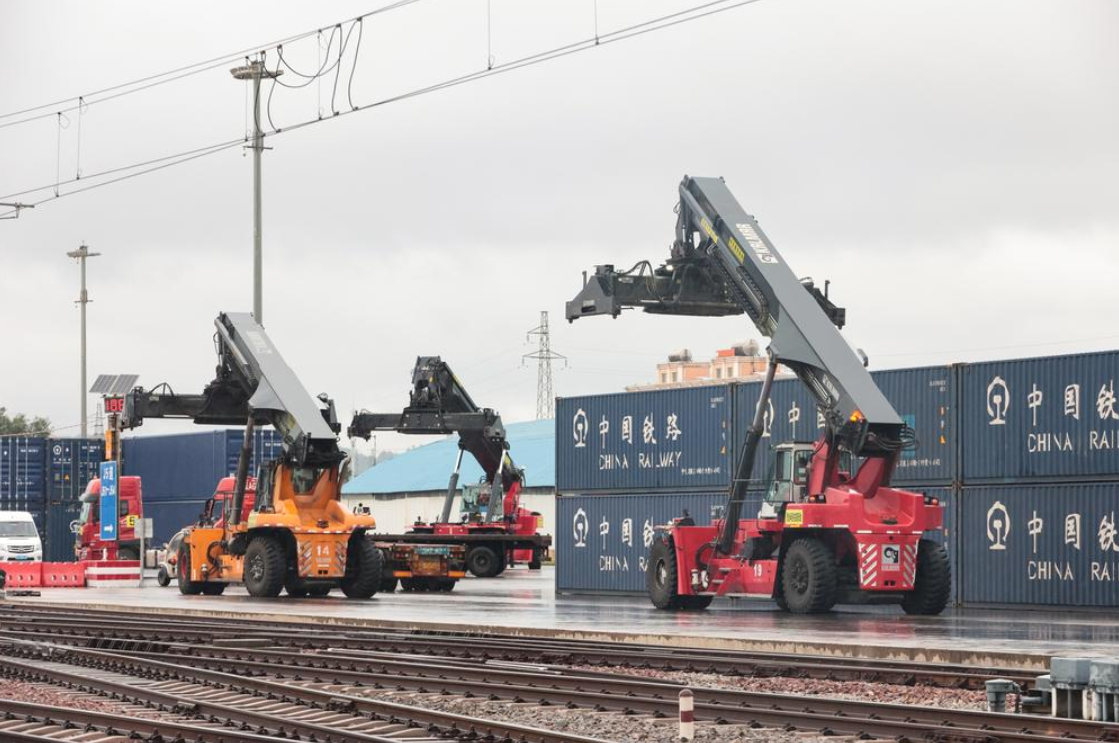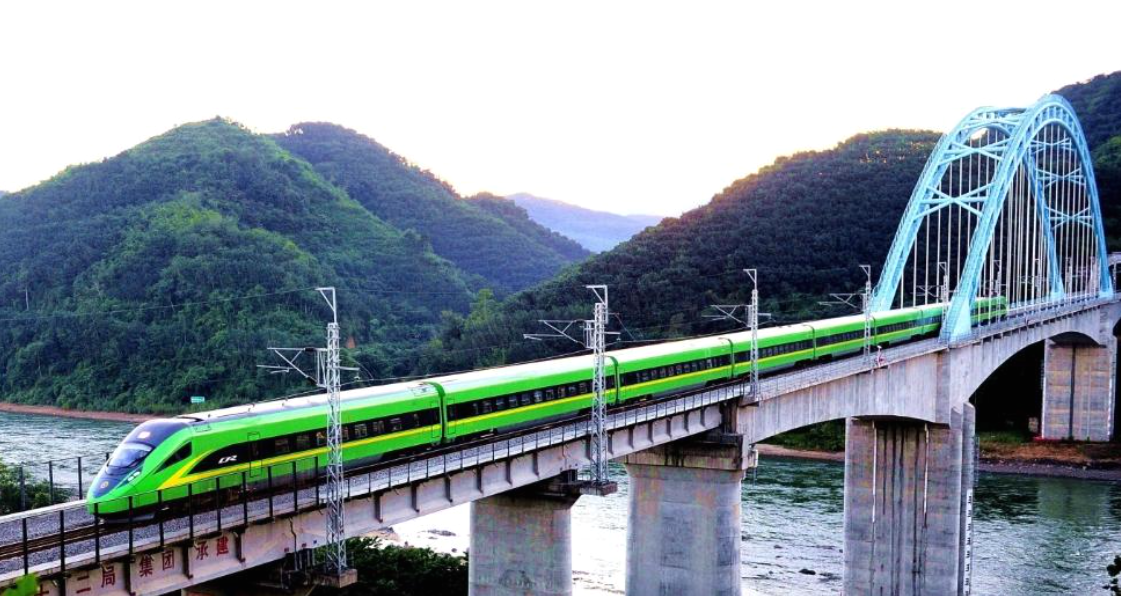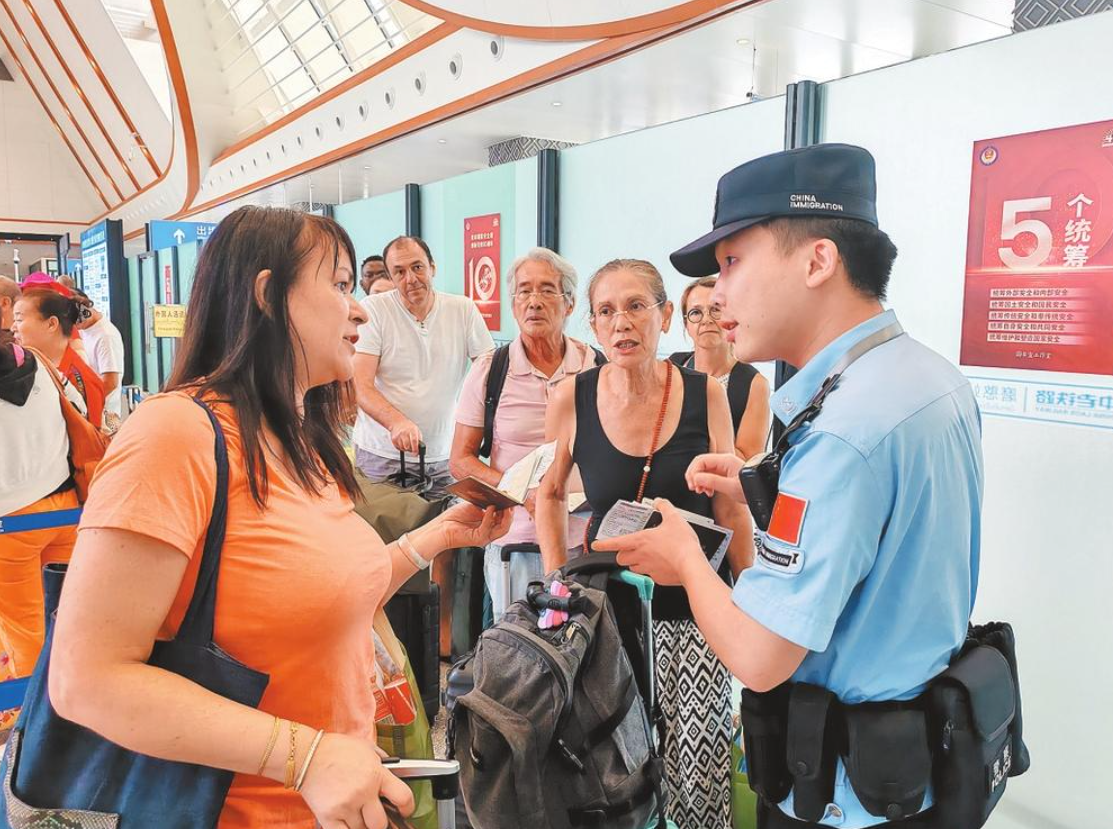Eric's Insight: China-Laos Railway drives regional growth, cultural exchanges
December 3, 2024 marks the third anniversary of the inauguration of the China-Laos Railway. Since its operation three years ago, the railway has been an impetus for regional investment cooperation, economic development and people-to-people exchanges.

Container-loading goes on at the CRIntermodal Kunming Terminal, also known as the Kunming Wangjiaying West container center.
Investment cooperation
Following its launch in December 2021, China-Laos Railway has seen the roll-out of a diversity of special train services. They include the Lancang-Mekong express trains that are connected to the China-Europe freight trains, the China-Laos-Thailand freight service, the Shanghai-Kunming-Vientiane international freight service, and the recent Beijing-Kunming-Vientiane freight service.
These special train services have allowed the China-Laos Railway to be linked to Beijing, Shanghai, Chongqing and other Chinese cities in the north, as well as to Thailand and other ASEAN countries in the south, putting Yunnan and Laos in a more favorable position to invite in investments from other regions.
Partly because of the railway's benefit, Fengyuan Lithium Energy Technology had its project in central Yunnan’s Yuxi city signed and put into production within a year. At the 2023 China Industrial Transfer and Development Matchmaking Activities (Yunnan), the province signed 382 industrial projects with diverse parties, with a planned total investment of 396.6 billion yuan. Industries are coming to the province in bulk.
“While investing in central Yunnan's Kunming, we take the China-Laos railway as a decisive factor, and we hope to invite more upstream and downstream industries to the city for a complete chain and join hands with them in doing business in South Asia, Southeast Asia and beyond,” said Chen Yong, vice president of Sugon Information Industry Co., Ltd during the matchmaking.
Under the dual-circulation development pattern, the railway's international freight trains will further bridge the Chinese market and other Asian regional markets, upgrade international cooperation between Yunnan and the outside world, and enhance Yunnan's position in the Belt and Road cooperation, observed Zhang Lei and Gao Lisha, associate professors at the Institute of International Relations, Yunnan University.
In 2006, the management of Zhonghe Rubber Company based in south Yunnan’s Pu'er city began to invest in agriculture in Laos because of geographical proximity, and later they established a branch in Luang Prabang. After years of development, the branch company now grows 240,000 mu (16,000 ha) of rubber in the northern Lao province, where more than 6,000 local independent growers joined them for benefit sharing.
"Our confidence in increasing investment in Laos has been greatly enhanced by the China-Laos Railway," said Yang Shixian, deputy general-manager of the Luang Prabang Zhonghe Rubber Co., Ltd. Relying on the railway’s international freight trains, the Luang Prabang company’s daily shipment of rubber products to China has increased from 20,000 tons three years ago to 37,000 tons this year.
Zheng Hong, president of the Yunnan Chamber of Commerce in Laos, thinks Yunnan enterprises have played a key role in the Mohan-Boten Economic Cooperation Zone across the China-Laos border, and coupled with the China-Laos Railway, the cooperation between Yunnan and Laos will usher in new momentum. "In the future, our chamber will encourage more Chinese businesses to invest in Laos, boosting investment cooperation between Laos and China," said Zheng.

Train passengers get through the busy Xishuangbanna Railway Station in south Yunnan.
Economic development
China-Laos Railway spurs regional trade and economic development. As a flagship project under the Belt and Road Initiative, the railway has allowed Yunnan specialties to access ASEAN market faster, while bringing more tropical fruits and ASEAN specialties to the vast Chinese market.
From January to July this year, the fruits transportation volume via China-Laos Railway exceeded 100,000 tons, up 119.85% year on year. As of mid-September, the railway has handled over 10 million tons of imported and exported goods since it was put into operation in December 2021.
Starting in September this year, Yunnan vegetables and fruits can be transported to Thailand within 3.5 days via a special Kunming-Vientiane-Bangkok rail and road service. At the packing workshop of the Wanhe Import and Export Company based in Tonghai county, central Yunnan’s Yuxi city, cold-storage trucks from China Railway Freight are engaged in loading and unloading operations.
“Our monthly shipment volume is 3,000 tons and daily sales reaches approximately 200,000 yuan,” said Zhang Xuxu, general manager of the Tonghai company. Since the operation of international freight trains on the China-Laos Railway, the company’s shipping mode for vegetables has largely shifted from road transport to rail transport.
“From Yuxi city, we transport fresh vegetables via the China-Laos Railway to Vientiane, Laos. Then they are transferred by road to Bangkok, arriving at the Thai fruit and vegetable market. The entire journey only takes three days,” said Zhang. Thanks to the China-Laos Railway, Yunnan vegetables have been sold to the ASEAN countries, countries in the Middle East and beyond, fueling the province’s high-quality development.
The railway has also brought more ASEAN specialties to Chinese consumers. At a Beijing supermarket specializing in craft beers, Beer Lao has become increasingly popular. "In June last year, I tried to put some Lao beer onto the shelf, but it turned out to be a hit among customers. They take the beer as refreshing and affordable," the supermarket owner Lin Yunchao said.
Behind the popularity of Lao beer is the strong logistics via China-Laos Railway that has contributed a lot to trade prosperity between the two countries. Hu Shengli, technical director of the Laos-based Tongda International Logistics Company, said the railway has brought Laos new opportunities for economic growth, citing the Lao cassava chips’ price ramp-up from 700 yuan per ton in 2021 to the current 1,200 yuan.
"Lao bananas grow up in tropical rainforest, and their fine taste is favored by Chinese consumers," said Zhang Zhongyi, an experienced fruit trader based in Beijing. China and Laos rolled out the Beijing-Kunming-Vientiane freight service on October 14, with the maiden train taking 390 tons of Lao bananas to the Beijing-Tianjin-Hebei markets. China imports some 700,000 tons of bananas from Laos yearly, and the bananas by the first train were sold out within two weeks.

A passengers' train runs through the railway's Yuanjiang Bridge in cnetral Yunnan's Yuxi city.
People-to-people exchanges
Since the Kunming-Vientiane direct passengers trains were launched in April 2023, the China-Laos Railway has emerged as a major regional route for international travel and cultural exchanges. On Sept. 24, the China-Laos tourist train StarExpress kicked off its maiden voyage from Yunnan’s Kunming city, passing through the UNESCO World Heritage city of Luang Prabang.
The number of passengers travelling to Luang Prabang via China-Laos Railway has been increasing since late October. By November 10, the Luang Prabang Station had handled more than 1 million passengers, up 51% year-on-year. Amid the craze in cross-border tours this year, the Laotian section of China-Laos Railway handled 14,912 passengers on November 17, setting a record high.
The railway offers a convenient travel option, enabling both locals and international tourists to explore Laos’ scenic landscapes and cultural sites. Hundreds of passengers use the Vientiane station daily, and many travel to popular destinations such as Vangvieng and Luang Prabang, according an article of the Lao News Agency.
"At the end of this year, I plan to travel to China with my family for a holiday. I think this is a great opportunity for us to learn about Chinese culture, traditions, and ways of life," said Chanthida, a 28-year-old student in Lao capital Vientiane.
The China-Laos Railway's Lao section has transported a total of 3 million passengers from Jan. 1 to Nov. 4, an increase of 44.4 percent from the same period in 2023. The passengers come from 101 countries. More than 2,800,000 passengers traveled within Laos, while over 108,000 passengers were transported by cross-border passenger trains, according to the Laos-China Railway Co., Ltd.
Yang Hongjian, manager of Yeyatang Valley Coffee Manor in southwest Yunnan’s Pu’er city, said the China-Laos Railway has helped in inviting more tourists to Pu'er for local culture and life styles, and the coffee garden has grown to be a comprehensive platform for global coffee lovers to learn coffee breeding, popular science and coffee tours.
Since 2023, Yeyatang has been visited by more than 3,000 per month, and the number doubled during holidays. An increasing number of tourists came from South Asia and Southeast Asia. "The China-Laos Railway has made it much easier for global visitors to experience the coffee culture in Pu'er, and more Pu'er coffee products will go beyond the Yunnan mountains through the international fright trains," said Yang.

French travellers go through a security check-up at the Mohan Railway Station near the China-Laos border.
Writing by Wang Shixue; Photos by Yunnan Daily; Proofreading by Zu Hongbing and Wang Huan